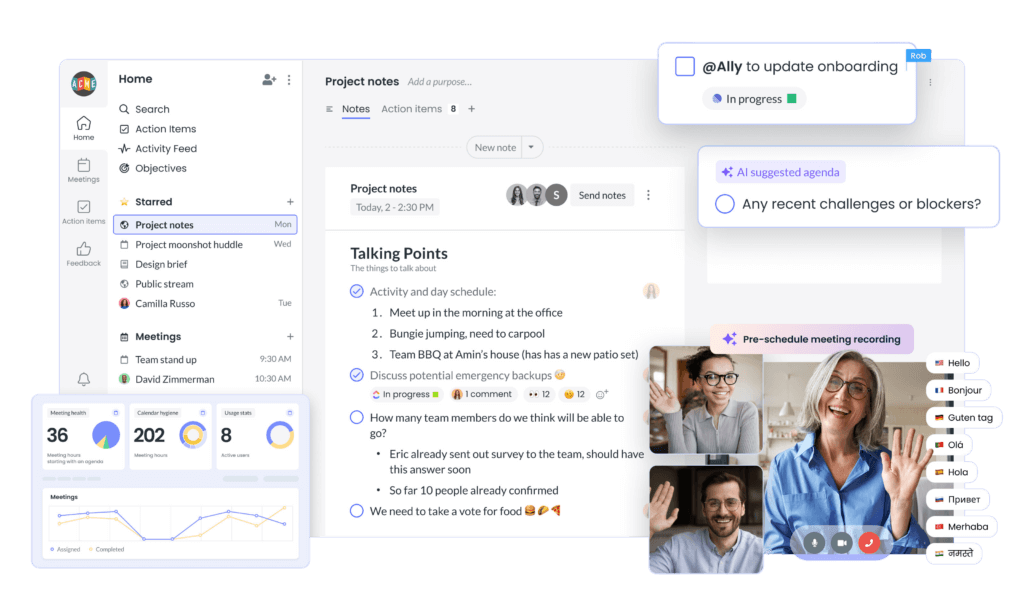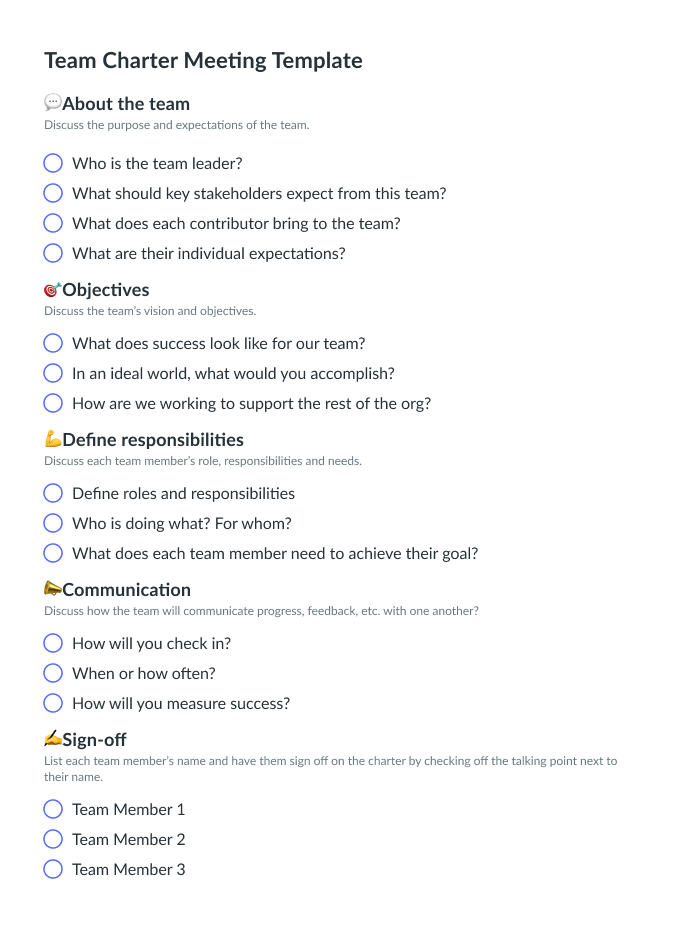How to Build Team Synergy & Why It’s Important (+ Examples)
Learn how to build team synergy—and how it can help your team improve performance and collaborate effectively toward a common goal.
Maintaining morale in the workplace is a big challenge for even the best managers. That’s even truer in hybrid or fully remote work environments, where new questions about teamwork and team cohesion pop up daily. Though we’ve never been more connected virtually, how do we keep that connection going beyond the screen? How can you create synergy to align your team with your organization?
Fostering team synergy is easy when you have the right information and tools. You might wonder: what does synergy mean, and why does it matter? Let’s get into it—consider this your guide to working better together.
- What is team synergy?
- Where team synergy begins
- Positive synergy vs. negative synergy
- 4 team synergy benefits
- How to create team synergy
- Team synergy strategies and examples
- From individuals to a cohesive whole with Fellow
What is team synergy?
Team synergy is the process of people or teams working together toward an outcome greater than the sum of their parts. It’s not the same as teamwork, but you also can’t have it without effective teamwork. In other words, teamwork is just working together, whereas synergy is the most evolved form of collaboration.
When an organization works together like a well-oiled machine, it increases productivity, leads to new ideas, and generally improves team members’ performance and cross-workspace collaboration. Ultimately, it matters because it creates an ideal working environment where people can count on one another. And that right there is the reason why we have teams in the first place.

Don’t let unproductive meetings
slow your team down
Take your team synergy to the next level with Fellow, the only all-in-one AI meeting transcription and management software for remote and hybrid teams. Seamlessly integrate Fellow’s AI meeting transcription and collaborative agendas to foster a culture of increased accountability and productivity, transforming your team’s synergy.

Where team synergy begins
Team synergy begins when you look at the larger picture and understand how each team member comes together to create a masterpiece. This differs from team development, which is how you train your team and develop their unique skills. Synergy goes beyond team development since it accounts for group dynamics when filling roles.
Ask yourself, how can I put together an all-star lineup? Then, assign clear roles and responsibilities to remove any uncertainty. This creates a streamlined workflow that produces success. It also creates that one-of-a-kind exciting feeling of being part of a team that works together to achieve the best outcome.
Positive synergy vs. negative synergy
The idea of synergy can definitely be exciting, but not everyone works well together, and that’s okay. Knowing this can be the key to creating positive synergy instead of negative synergy. Positive synergy occurs when the right people receive the right information for effective teamwork and your organization’s greater good. Negative synergy occurs when you hire a new team member who’s just not a fit for the team.
This person might have all the qualifications on paper, and their role could bring something special to the group. However, if they don’t jive with the existing dynamic, it could create chaos. In short, synergy is a delicate ecosystem that requires maintenance and balance to keep on a positive path instead of a negative one.
4 team synergy benefits
Here’s why so many organizations put so much effort into team synergy.
Better performance
When a team works well together, you can always expect better results. Additionally, when team members completely jive, they do their best individually too, which often leads to more positive performance reviews. With everyone putting their best foot forward, there’s no task you can’t accomplish.
More innovation
Bringing diverse thoughts to the table can create more innovation, so it makes sense that team synergy can lead to new ways of looking at things. When you’re crafting your dream team, choose people who work well together and bring a unique perspective. This can take your team to new heights you never imagined reaching.
Smarter resource usage
With clear roles and responsibilities, your team can divide and conquer for maximum results. Since everyone is working together toward a common goal, you’ll cut down on the duplication of efforts and boost your efficiency.
Increased morale and job satisfaction
There’s nothing quite like working with a good team—there’s a satisfaction that comes from knowing you’re in this together. Positive synergy does wonders for employee morale—you’re the captain of a ship that’s bound for open waters and limitless possibilities.
How to create team synergy
Ready to start building team synergy? Here’s how to make it happen.
- Recognize each team member’s unique talents and strengths
- Create the right team culture
- Make sure your team’s vision and goals are aligned
- Be smart about how you set roles and responsibilities
- Celebrate your wins
Recognize each team member’s unique talents and strengths
To most easily create synergy, play to everyone’s strengths and talents. Do this when developing your team and filling the roles your organization needs.
Communication is key in any good relationship, so ask your team members what strengths they bring to the table. Encourage them to take an assessment that determines their personality type, working style, or communication style. Then, as a team-building exercise, you can bring the group together to share their results. This allows everyone to figure out how to work together to uplift one another.
With Fellow’s feedback feature, it’s easy to recognize your team members’ talents and strengths and ask for feedback. By leveraging this feature, you can create a team culture in which the giving, receiving, and implementing of feedback becomes a natural part of your DNA, ultimately boosting team morale and performance.

Create the right team culture
Within a great culture, your team members will be comfortable enough to bring their best selves to work. Think of your team like a garden—without the right soil, sunlight, and other environmental conditions, how can you expect them to blossom? How can you reap the rewards of the bountiful harvest you’ve worked so hard to achieve?
Great culture starts with psychological safety in the workplace. When you pull that off, your team members will feel unafraid to ask questions, make mistakes, and share their ideas without fear of negative repercussions. You’ll empower everyone to grow while showing up as unapologetically themselves, which is what you want—after all, you ultimately hired them to be themselves.
Make sure your team’s vision and goals are aligned
For team synergy to thrive, there has to be harmony between your team’s vision and your team’s goals. To achieve this, ensure any assigned tasks are relevant to what you’re all working toward. If the first step is to create everyone’s to-do lists, then the next step is communication on your team’s overall goals. This clarity offers your crew a bigger picture—a guiding light they can count on when the waters ahead are murky.
With Fellow’s objectives and key results feature, your team can have visibility into objectives and goals, creating a culture of collective accountability and synergy. These OKRs can be embedded into your team meeting and 1:1 agendas, making it easier to stay aligned.

Be smart about how you set roles and responsibilities
Assign roles and responsibilities that power team development while allowing everyone to lean on their strengths. This way, you maximize everyone’s potential. You also give your team another morale boost because everyone will feel like a valued team player. You’ll put your people in a position to take risks and develop innovative solutions.
Celebrate your wins
Sometimes, a project can last a while, so it might be a bit before your team fully reaches the desired end result. To maintain positive team synergy along the way, celebrate project milestones and wins. Make it about the journey, as well as the destination—that’s how you keep creativity and morale with you at every step.
When mapping out a project, include your milestones in the plan. This way, everyone is always working toward smaller goals as well. When that happens, you’ll drive employee engagement that keeps everyone motivated.
Team synergy strategies and examples
Try any of these for your own team to bring team synergy to your workplace.
- Writing a team charter
- Doing team-building activities
- Being more intentional in your communication
- Professional training and development
Writing a team charter
Since most organizations have a mission statement, why not also create one for your team that aligns with the larger one? To create this team charter, outline who the team leader is, set objectives and responsibilities, and decide how you’ll communicate. When you feel your team is veering off course, refer to your charter. Remind them of what you all agreed on to get things back on track.
To ensure that everyone on your team has a chance to give their input while creating your team charter, use Fellow’s expert-approved Team Charter Meeting Template. This template is fully customizable, so you can tailor it to your team’s unique needs.

Doing team-building activities
Group synergy thrives on great interpersonal relationships, and those come from actively making room for bonding time. With team-building exercises, you can take time out of the workday to very literally play games—trivia, Pictionary, you name it.
You can also schedule the occasional retreat or happy hour outside your work hours. These activities will help you learn more about your team members and build stronger bonds.
Being more intentional in your communication
Communication isn’t just a necessary part of any relationship—it’s also the bedrock of teamwork and synergy. When you and your team communicate regularly, you all build a platform to receive feedback, voice concerns, and share impromptu project thoughts.
A great way to do this on top of weekly and one-on-one meetings is to plan, for example, go-to-market bi-weekly sync meetings. You can better coordinate upcoming launches and set aside time for check-ins that might otherwise go overlooked.
Professional training and development
It’s a common mistake to train people only during the onboarding process. However, if you want to build team synergy and see your team truly thrive, you should view training and talent development as an ongoing process. When you invest in team members and provide them with the right tools to learn and grow, they feel more valued. From there, they’ll be more likely to work well with the whole group.
From individuals to a cohesive whole with Fellow
Positive synergy is all about everyone coming together to create something bigger than each person. It’s the epitome of collaboration, and it’s what every organization is looking to achieve—and with Fellow, you can create it for any team from anywhere.
With Fellow, you regularly give team members the feedback they need, keeping everyone motivated and in the loop. You can also offer words of encouragement and share areas of improvement using performance review meeting templates. Plus, with Fellow’s AI transcriptions and AI meeting summaries, you’ll effortlessly record all your decisions and discussions to keep everyone aligned. Alignment, communication, and psychological safety are the building blocks of synergy, and with Fellow, you get it all.












